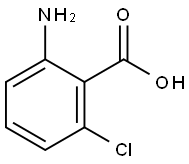
5-CHLORO-2-METHYLQUINAZOLIN-4(3H)-ONE synthesis
- Product Name:5-CHLORO-2-METHYLQUINAZOLIN-4(3H)-ONE
- CAS Number:19407-56-8
- Molecular formula:C9H7ClN2O
- Molecular Weight:0
Yield:19407-56-8 72%
Reaction Conditions:
Stage #1: 2-chloro-6-aminobenzoic acid;acetic anhydride at 20;
Stage #2: with ammonia in water at 20; for 7 h;
Steps:
4.2. Preparation of quinazolin-4(3H)-one derivatives
General procedure: To a three necked flask, substituted anthranilic acid (1 meq.) was added in excess of formamide (6 meq). The reaction mixture was then heated at 140 °C for 4-6 h. The reaction was monitored with thin layer chromatography and upon completion; ice was added to the reaction mixture. The resultant solid was filtered, washed with water, dissolved in ethyl acetate, dried over MgSO4 and concentrated to obtain the pure desired product. Where product did not precipitate on addition of ice, the reaction mixture was extracted with ethyl acetate, dried over MgSO4 and concentrated to obtain the desired quinazolin-4(3H)-one derivatives 1-9, 11-15, 17-21 and 23-25.The amino derivatives 10, 16 and 22 were prepared using the following general procedure:To a reaction flask, substituted nitroquinazolin-4(3H)-one derivative (0.3 g, 1.56 mmol) was added followed by addition of 6 mL ethyl acetate and SnCl2·2H2O (2.12 g, 9.42 mmol), then reaction mixture was refluxed for 8 h. The reaction mixture was cooled to room temperature and quenched with saturated sodium bicarbonate solution, followed by repeated extraction with ethyl acetate (3 × 50 mL). The organic layers were combined, dried over anhydrous MgSO4 and concentrated to obtain the desired amino substituted quinazolin-4(3H)-one derivatives 10, 16 and 22.The substituted anthranilic acid (1 g) was dissolved in excess acetic anhydride (10 mL) and the resulting reaction mixture was stirred at room temperature for 4-7 h. The reaction was monitored for completion using thin layer chromatography. The solvent was evaporated under vacuum and the resultant residue was stirred with ammonia solution for 7 h. Upon completion, the reaction mixture was extracted with ethyl acetate (3 × 10 mL), the organic extracts were combined, dried over MgSO4 and evaporated to obtain compounds 26-30, 31a and 32. The 2-methyl-8-nitroquinazolin-4(3H)-one intermediate (31a) was reduced to compound 31 using the same procedure as reported in Scheme 1 for the synthesis of compounds 10, 16 and 22.
References:
Kulkarni, Shridhar S.;Singh, Satyakam;Shah, Janki R.;Low, Woon-Kai;Talele, Tanaji T. [European Journal of Medicinal Chemistry,2012,vol. 50,p. 264 - 273] Location in patent:experimental part

